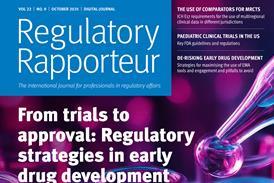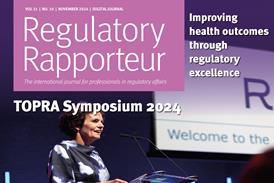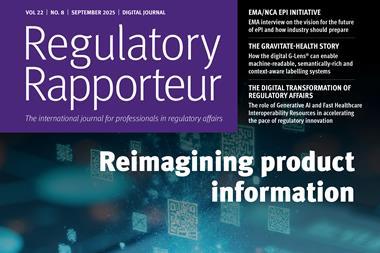European Union (EU) pharmaceutical legislation – known as the Clinical Trial Regulation (EU-CTR), came into effect on 31 January 2022. It aims to ensure the EU offers an attractive and favourable environment for carrying out clinical research on a wider scale, with high standards of public transparency and safety for clinical trial participants.
A predominant challenge that is frequently observed in the construction of the investigational medicinal product dossier (IMPD) is that recommendations provided in the EU-CTR and applicable EMA guidelines, European Pharmacopoeia (Ph. Eur.) monographs and European Directorate of the Quality of Medicines (EDQM) standard terms database may not be taken into consideration. Therefore, non-compliance with EU requirements means that validation queries and requests for information (RFIs) are raised during the review of the clinical trial application (CTA).
The aim of this article is to provide key awareness and guidance on IMPD requirements for sponsors planning to submit CTAs via the EU-CTR. Potential challenges are outlined.
Licence notice
Copyright © 2015-2024 The Organisation for Professionals in Regulatory Affairs Ltd. T/A Regulatory Rapporteur − All Rights Reserved. This work is licensed to TOPRA for the purposes of academic and personal reasonable use only.
Notwithstanding this licence, no part of materials published in Regulatory Rapporteur may be reproduced without the express written permission of the publisher.
As a general rule, permission should be sought from the rights holder to reproduce any substantial part of a copyrighted work. This includes any text, illustrations, charts, tables, photographs, or other material from previously published sources.
To obtain permission(s) to re-use content published in Regulatory Rapporteur please email publications@topra.org.
To join TOPRA please click here.

Regulatory Rapporteur
January 2023 | Volume 20 | No.1
Introduction
The EU-CTR[1] harmonises the processes for assessment and supervision of clinical trials throughout the EU. The evaluation, authorisation and supervision of clinical trials are the responsibilities of EU member states (MS) and European Economic Area (EEA) countries. Prior to the Regulation, clinical trial sponsors had to submit CTAs separately to national competent authorities and ethics committees in each country to gain regulatory approval to run a clinical trial. The Regulation enables sponsors to submit one online application via a single online platform known as the Clinical Trials Information System (CTIS) for approval to run a clinical trial in several EU MS/EEA countries, making it more efficient to carry out such multinational trials.
At the time of writing this article (December 2022), as we rapidly approach the 31-Jan-2023 deadline for mandatory submission via the EU-CTR for new CTAs, it is very important for regulatory professionals to provide clear and accurate advice in relation to content, redaction and publishing requirements for an EU IMPD that will be submitted as part of an EU-CTR CTA.
The EMA has issued detailed guidelines regarding quality requirements for IMPs. Some sponsors such as biotechnology companies may be experienced with regards to US FDA requirements; however, they may have limited experience with EMA requirements.[2] Furthermore, the sponsor is often under pressure to meet corporate submission milestones to satisfy investors. It is common for sponsors such as small start-up biotechnology companies to take a high-risk approach, to the detriment that the IMPD may not be in full accordance with EMA requirements and expectations for the initial CTA submission.
In January 2022, revised EMA guidelines on the requirements for quality documentation concerning IMPs containing chemically defined[3] and biological/biotechnology -derived drug substances[4] came into effect. Industry stakeholders provided comments regarding the corresponding guidance documents when being revised by the EMA’s Biological Working Party (BWP) and Quality Working Party (QWP), respectively. These guidelines were devised to be seen in connection with the EU-CTR. Since clinical trials will often be designed as multi-centre studies, potentially involving different EU MS, these guidelines are aimed to define harmonised requirements for the documentation to be submitted throughout the EU.
It is highly recommended that sponsors unfamiliar with EU-CTR requirements, ask an EU IMPD subject matter expert to review the IMPD to identify potential gaps prior to submission… the country mix chosen… also needs to be taken into consideration…
Furthermore, there are Ph. Eur. monographs for some biopharmaceuticals, eg, monoclonal antibodies[5] and gene transfer medicinal products[6], and the EDQM has a standard terms database for pharmaceutical forms[7] that are acceptable in the EU. It is observed that recommendations in EMA guidelines, applicable Ph. Eur. monographs and the EDQM standard terms database are often not taken into complete consideration when authoring an IMPD. Noncompliance with EU requirements means that RFIs are raised during the CTA review that sometimes cannot be resolved in time to meet agency response deadlines.
Critically, this can result in sponsors having to withdraw a CTA or sometimes rejection of a CTA due to the inability to provide information to address RFIs. This may lead to delays in site activation and/or not being able to conduct the study in some EU MS. Such delays that are directly on the critical path can be highly significant for a small biotech in terms of time, cost and meeting investor-driven milestones (cash flow).
The aim of this article is to provide guidance on the requirements for sponsors preparing an IMPD to include in CTAs that will be submitted via the EU-CTR. Best practice when authoring and publishing an IMPD is discussed.
Table 1: Impact of EU-CTR on the IMPD
| Important considerations | Comment | Recommendations |
|---|---|---|
| Content of the IMPD | There is no major impact of the EU-CTR1 on the IMPD content. It should follow the electronic Common Technical Document (eCTD) structure and provide information on the quality, manufacture and control of the IMP (see recommendations regarding compliance with EMA Quality Guidelines for IMPs and sIMPD in Table 2). | Cross-reference to the investigator’s brochure (IB) /clinical study protocol is recommended for the nonclinical, clinical and benefit-risk sections to avoid duplication of information already available elsewhere in the CTA. |
| Compliance with updated EMA Quality Guidelines for Investigational Medicinal Products | EMA has published detailed IMPD Quality Guidelines for both chemical3 and biological/biotechnological4 substances. Since 2017, both guidelines are seen in connection with the EU-CTR, and the latest revisions came into e¡ect in January 2022. The chemistry, manufacturing and controls (CMC) requirements between the EU and the US or other regions might di¡er, especially for the early clinical phase. | For sponsors considering conducting clinical studies in EU MS, it is important to comply with EU CMC requirements to reduce the risk of a member state concerned (MSC) to issue RFIs. |
| New guidance on what changes warrant submission of a substantial modification (SM) | Revision 2 of the guidelines3, 4 focused on changes to the IMP to align with the categories of changes made to the IMPD with the EU-CTR. The revision added further examples and clarity to the changes requiring submission of an SM. | The examples in the guidelines are provided to help sponsors in classi cation of changes. There is a good range of examples, but they are not comprehensive. Therefore, each change should be assessed on a case by-case basis and should focus on patient safety |
| Submission requirements – publishing of the IMPD | For protection of proprietary information and due to publication requirements, the quality section of the IMPD (IMPD-Q) has to be published separately from the safety and efficacy sections of the IMPD (IMPD-S+E). | |
| Submission of IMPD – limit with respect to file size | There is a le size limitation of 50 MB in the electronic submission portal CTIS for pdf files. | If the IMPD-Q pdf le exceeds 50 MB, then it will need to be split into IMPD-Q-Drug Substance and IMPD-Q-Drug Product + Appendices |
| Authorised and unauthor ised medicinal products to be used in a clinical trial are required to be registered in the eXtended EudraVig ilance Medicinal Product Dictionary (XEVMPD) | The registration must have occurred for the following to be available for inclusion in the CTIS application: EU substance number and EU medicinal product number Note: Placebo information does not need to be included in XEVMPD. | |
| Transparency requirements | Documents that fall under transparency requirements will be made public as soon as the first MSC has made their decision. However, the IMPD-Q, CMC scientific advice, and RFIs related to quality are exceptions and are all treated as con dential information and are not made public. | |
| Redaction requirements | Redaction is not required for the IMPD-Q, as it is not subject to publication (refer to transparency requirements). | Redaction of the IMPD-S+E may need to be considered if cross-reference to the IB or the clinical study protocol is not possible (eg, if the benefit-risk assessment provided in one of these documents is not speci c to the proposed clinical trial). |
Impact of EU-CTR on the EU IMPD
Important considerations when preparing an IMPD that needs to be included in a CTA to be submitted via the EU-CTR portal are summarised in Table 1. Content, submission and publication considerations are discussed.
Other points to consider when preparing an EU IMPD
Other important considerations when preparing an EU IMPD are summarised in Table 2.
Table 2: Other important points to consider when preparing an EU IMPD
| Important considerations | Comment | Recommendations |
|---|---|---|
| Simplified IMPD (sIMPD) approach to reduce risk of RFIs from an MSC. |
|
|
| Early identification of EU importation and qualified person (QP) release site. | The EU importation and QP release site (also responsible for the QP declaration) are important aspects of the clinical supply chain and must be listed in the IMPD. | Early identification of the site(s) and early discussion with the QP on the supply chain are critical to avoid potential delay in the start of the study (eg, need of good manufacturing practice (GMP) audits for a manufacturing site located in a third country, eg, China or India8 , to confirm that it manufactures in accordance with EEA GMP requirements). |
| Raw materials of human or animal origin | Documentation addressing safety evaluation of adventitious agents and viral safety should be provided in the IMPD. | For example, bovine spongiform encephalopathy/ transmissible spongiform encephalopathy statements, certi cate of origin, CEPs, and plasma master files. |
| Shelf-life extension plan | A shelf-life based on the available stability data (long-term and accelerated) and following the IMPD guidelines extrapolation rules must be defined in the IMPD. | A shelf-life extension plan should also be included in the IMPD to allow for future extensions without requirement of an SM. |
* Auxiliary medicinal products (medicinal products used in the context of a clinical trial but not as investigational medicinal products), such as medicinal products used for background treatment, challenge agents, rescue medication, or used to assess endpoints in a clinical trial.
Discussion and conclusions
When preparing an IMPD to include in a CTA that will be submitted via the EU-CTR, it is important to be aware of applicable EMA guidance documents, and publishing requirements to protect proprietary information regarding the manufacturing of the IMP and Ph. Eur. monographs to avoid potential RFIs during review. Furthermore, the EU-CTR states: ‘The risk to subject safety in a clinical trial mainly stems from two sources: the investigational medicinal product and the intervention’ – hence the importance of maintaining exact visibility of the product’s CMC in relation to the requirements of the EU-CTR.
Regarding the content in the quality section of the IMPD, common issues for both chemical and biological IMPs that may result in RFIs are as follows:
- Using ‘report results’ as an acceptance criterion in a specification for an investigational medicinal product that will be evaluated in a Phase II or Phase III clinical trial.
- Not using an EDQM standard term for the pharmaceutical dosage form.
- Site for QP release located in an EU MS not listed in the IMPD.
- Not including a statement to confirm the batch analyses data presented are from the drug product batches that will be used in the clinical trial, or whether additional batches not yet manufactured at time of submission of the IMPD might be used.
- Not stating clearly, the regulatory status of a medical device in the IMPD, eg, if it has a CE mark.
- Retest extension plan for the drug substance and shelf-life extension plan for the drug product are not in accordance with EMA requirements.
It is highly recommended that sponsors unfamiliar with EU-CTR requirements, ask an EU IMPD subject matter expert to review the IMPD to identify potential gaps prior to submission via the EU-CTR. The country mix chosen for the initial EU-CTR submission also needs to be taken into consideration, as certain MSC (eg, Czechia, France, Germany and Spain) have very stringent requirements with respect to CMC and viral safety. This means that EMA guidelines should be carefully followed when authoring the IMPD, and content should be aligned closely with the appropriate Phase requirements for the proposed clinical trial outlined in the EMA quality guidelines3,4 for IMPs.
The approval process for an SM is longer and more onerous for clinical trials submitted under the EU-CTR compared to those submitted under Directive 2001/20/EC. The EU-CTR establishes an overall minimum timeline of 50 days for EU MS to evaluate an SM. This deadline may be extended in case that RFIs are raised by an MSC throughout the evaluation process. Timelines can be extended up to 15 days for RFIs raised in the validation phase (ten days for sponsors to respond and five days for MSC to review the response), and up to 31 days for RFIs raised in the assessment phase.
Multiple RFIs can be raised during the different phases of the evaluation process. However, it should be noted that when multiples RFIs are raised, each of them will have its own deadline, and the overall timeline will be only extended once. This means that sponsors should ‘future proof’ the IMPD when preparing for the initial submission to minimise the number of potential substantial modifications during the clinical trial. Sponsors should aim to use strategies such as a shelf-life extension plan to minimise the need for substantial modifications during the maintenance phase of the clinical trial.
In conclusion, when authoring and publishing an IMPD for inclusion in a CTA that will be submitted via the EU-CTR, it is suggested to follow the recommendations in the EMA quality guidelines for IMPs and the requirements for publishing of the IMPD that are outlined on the EU-CTR pages on the EMA website. Using the sIMPD approach where possible will also help to reduce the risk of sponsors receiving CMC-related RFIs during the review period of the EU-CTR. Finally, when authoring the IMPD, it is recommended that particular care and attention be taken with respect to content to minimise the risk of having to submit substantial modifications during a clinical trial.
References
[1] European Commission. (2014) REGULATION (EU) No 536/2014 OF THE EUROPEAN PARLIAMENT AND OF THE COUNCIL of 16 April 2014 on clinical trials on medicinal products for human use, and repealing Directive 2001/20/EC. Available at: EUR-Lex - 32014R0536 - EN - EUR-Lex (europa.eu)
[2] Watkins J. The CMC section of an EU IMPD: Considerations for US Sponsors, Regulatory Rapporteur – Vol 16, No 2, February 2019.
[3] EMA. (2022) Guideline on the requirements for the chemical and pharmaceutical quality documentation concerning investigational medicinal products in clinical trials. Available at: Guideline on the requirements for the chemical and pharmaceutical quality documentation concerning investigational medicinal products in clinical trials (europa.eu)
[4] EMA (2022) Guideline on the requirements for quality documentation concerning biological investigational medicinal products in clinical trials. Available at: Guideline on the requirements for quality documentation concerning biological investigational medicinal products in clinical trials (europa.eu)
[5] European Pharmacopoeia Monograph (2031): Monoclonal antibodies for human use. European Pharmacopoeia General Chapter (5.14):
[6] Gene transfer products for human use EDQM standard terms database, Available at: Standard Terms (edqm.eu)
[7] Watkins J & Ryder C Marketing applications for biopharmaceuticals: Considerations for different jurisdictions – Part 2, Regulatory Rapporteur – Vol 14, No 11, November 201


























